Comprehensive Analysis of Agency and Corporation Law Concepts
VerifiedAdded on 2021/06/17
|10
|2375
|64
Homework Assignment
AI Summary
This document presents a comprehensive analysis of an agency and corporation law assignment. The assignment addresses two primary issues: the existence of a contract and the nature of authority in an agency relationship, and the personal liability of individuals within a corporate structure. The analysis delves into key legal principles, including actual, express, implied, and ostensible authority, and the doctrine of undisclosed principal, supported by relevant case law such as *Watteau v Fenwick*, *Freeman & Lockyer v Buckhurst Park Properties*, and *Salomon v Salomon & Co Ltd*. The assignment applies these legal concepts to specific scenarios, evaluating the liabilities of various parties. Furthermore, the document explores the concept of a company as a separate legal entity, the principle of the corporate veil, and the potential for lifting the veil in cases of legal circumvention, referencing cases like *Daimler Co v Continental Tyre and Rubber Co* and *Gilford Motor Co Ltd v Horne*. The conclusion summarizes the findings regarding contractual obligations, the scope of authority, and the extent of liability for both individuals and corporations.
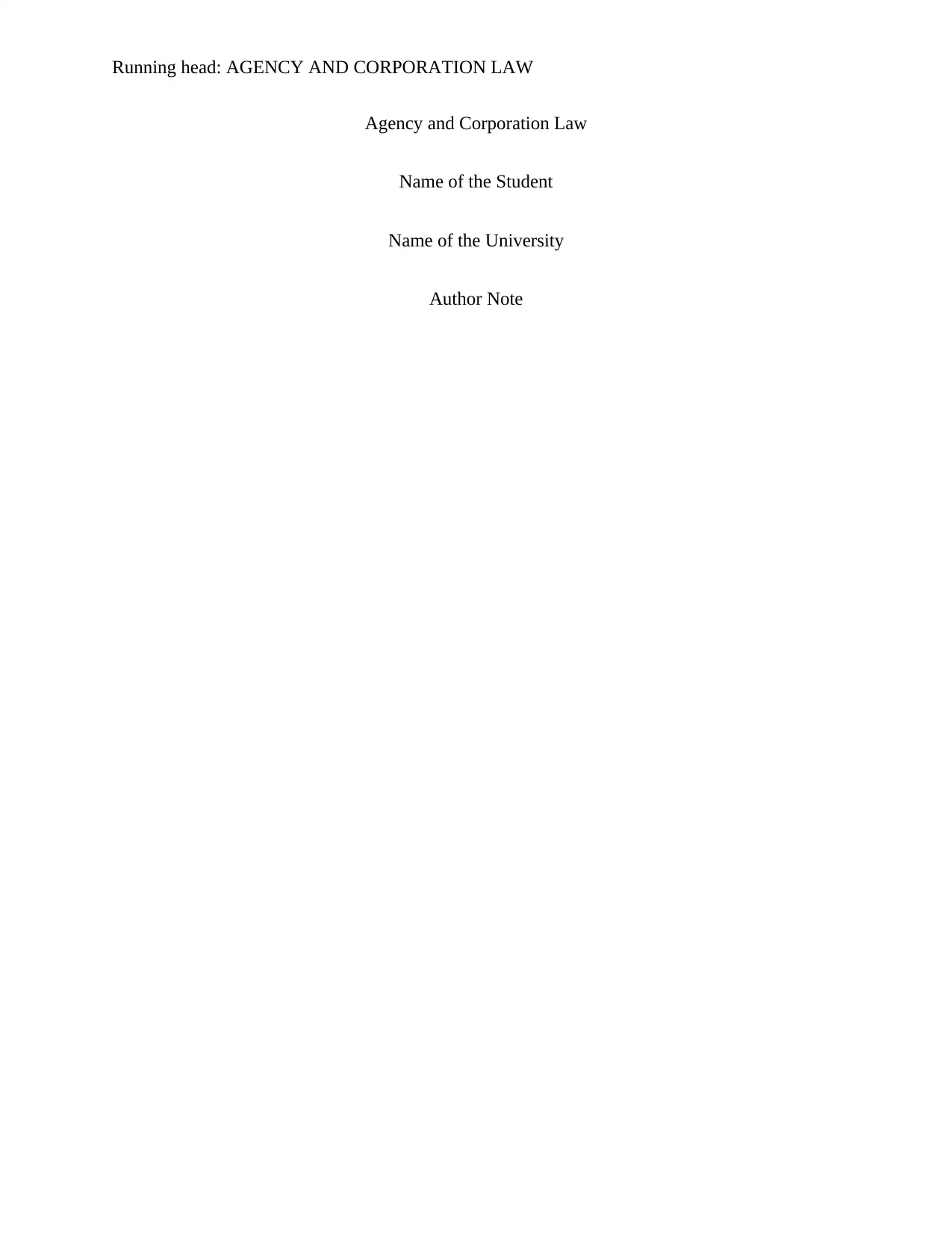
Running head: AGENCY AND CORPORATION LAW
Agency and Corporation Law
Name of the Student
Name of the University
Author Note
Agency and Corporation Law
Name of the Student
Name of the University
Author Note
Paraphrase This Document
Need a fresh take? Get an instant paraphrase of this document with our AI Paraphraser
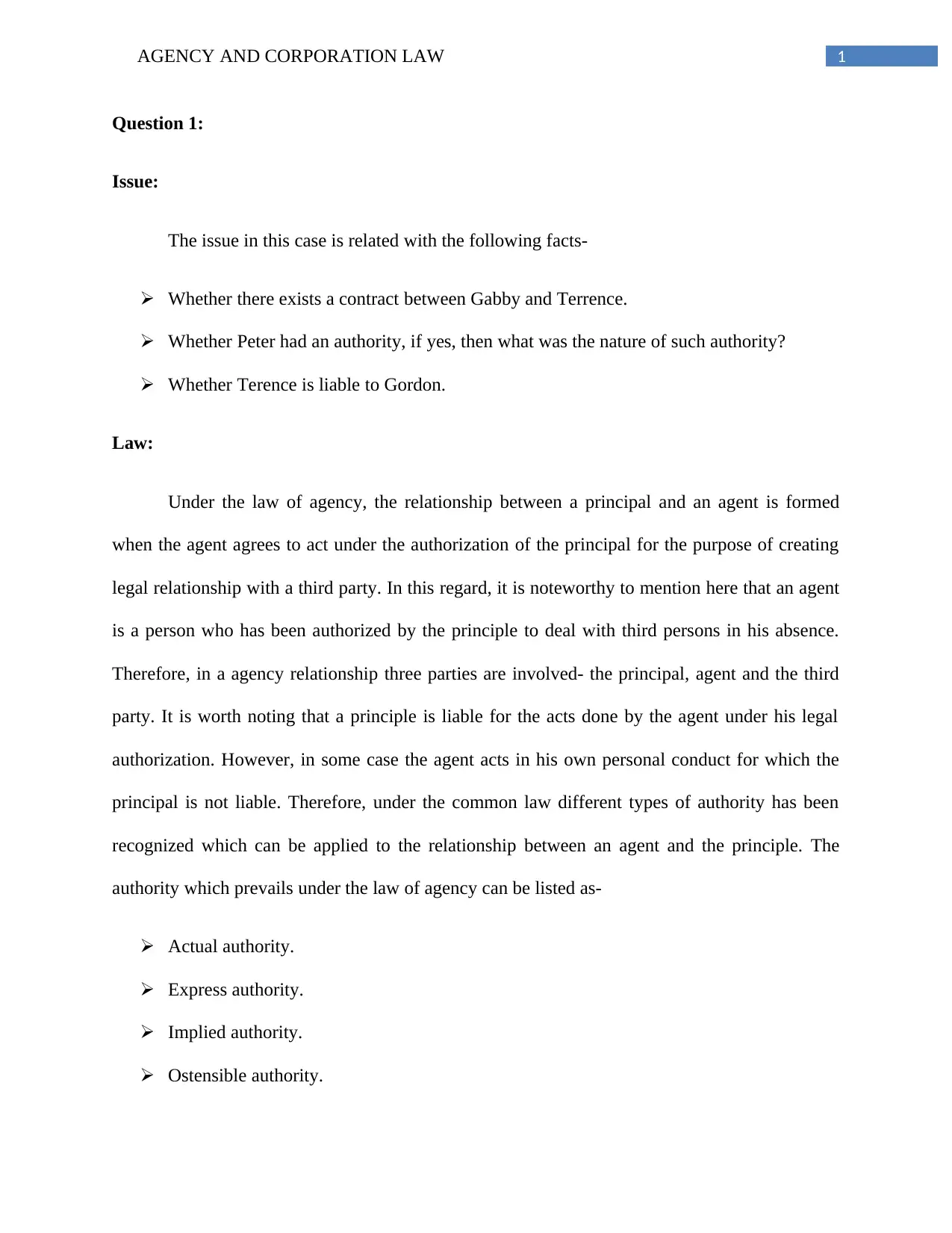
1AGENCY AND CORPORATION LAW
Question 1:
Issue:
The issue in this case is related with the following facts-
Whether there exists a contract between Gabby and Terrence.
Whether Peter had an authority, if yes, then what was the nature of such authority?
Whether Terence is liable to Gordon.
Law:
Under the law of agency, the relationship between a principal and an agent is formed
when the agent agrees to act under the authorization of the principal for the purpose of creating
legal relationship with a third party. In this regard, it is noteworthy to mention here that an agent
is a person who has been authorized by the principle to deal with third persons in his absence.
Therefore, in a agency relationship three parties are involved- the principal, agent and the third
party. It is worth noting that a principle is liable for the acts done by the agent under his legal
authorization. However, in some case the agent acts in his own personal conduct for which the
principal is not liable. Therefore, under the common law different types of authority has been
recognized which can be applied to the relationship between an agent and the principle. The
authority which prevails under the law of agency can be listed as-
Actual authority.
Express authority.
Implied authority.
Ostensible authority.
Question 1:
Issue:
The issue in this case is related with the following facts-
Whether there exists a contract between Gabby and Terrence.
Whether Peter had an authority, if yes, then what was the nature of such authority?
Whether Terence is liable to Gordon.
Law:
Under the law of agency, the relationship between a principal and an agent is formed
when the agent agrees to act under the authorization of the principal for the purpose of creating
legal relationship with a third party. In this regard, it is noteworthy to mention here that an agent
is a person who has been authorized by the principle to deal with third persons in his absence.
Therefore, in a agency relationship three parties are involved- the principal, agent and the third
party. It is worth noting that a principle is liable for the acts done by the agent under his legal
authorization. However, in some case the agent acts in his own personal conduct for which the
principal is not liable. Therefore, under the common law different types of authority has been
recognized which can be applied to the relationship between an agent and the principle. The
authority which prevails under the law of agency can be listed as-
Actual authority.
Express authority.
Implied authority.
Ostensible authority.
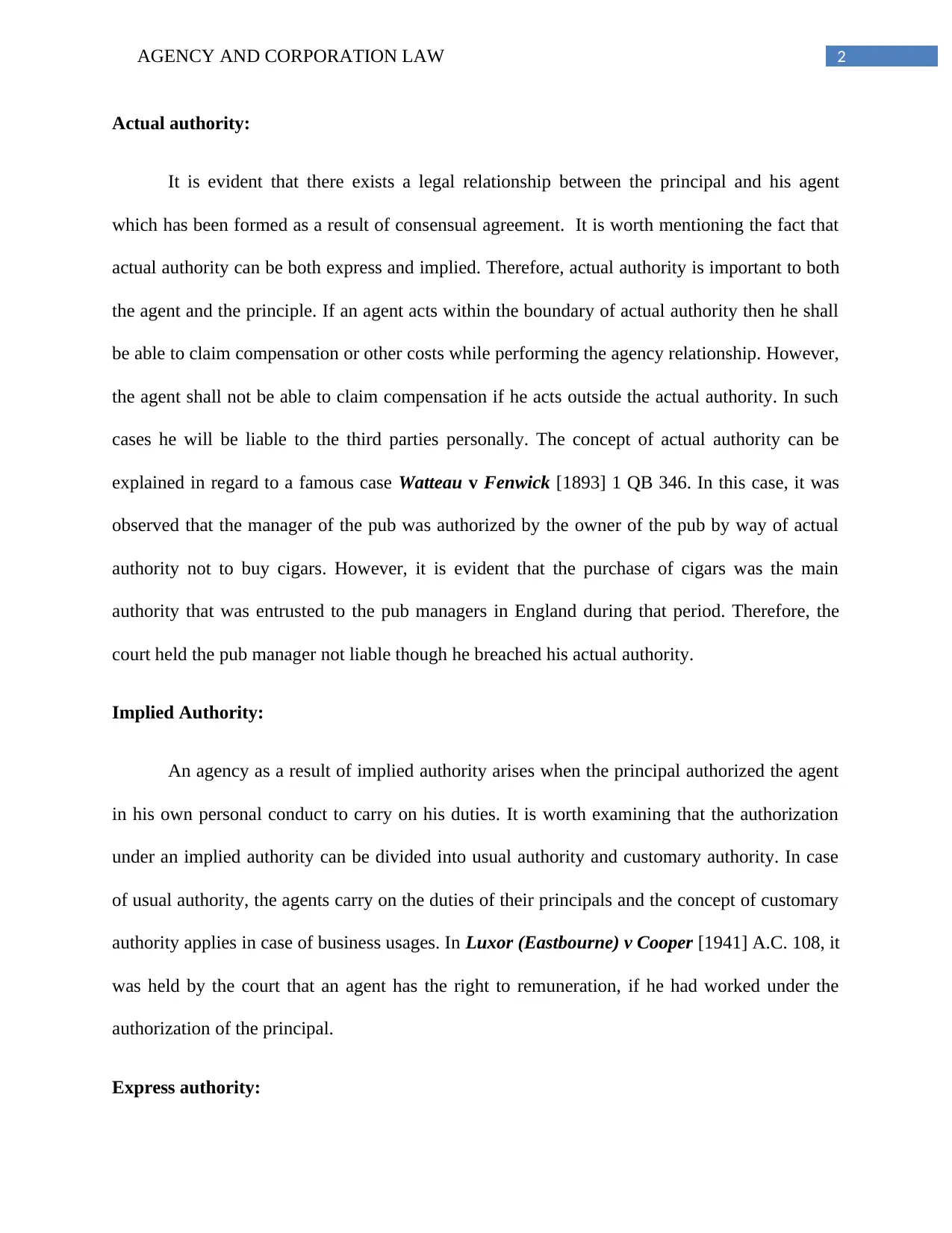
2AGENCY AND CORPORATION LAW
Actual authority:
It is evident that there exists a legal relationship between the principal and his agent
which has been formed as a result of consensual agreement. It is worth mentioning the fact that
actual authority can be both express and implied. Therefore, actual authority is important to both
the agent and the principle. If an agent acts within the boundary of actual authority then he shall
be able to claim compensation or other costs while performing the agency relationship. However,
the agent shall not be able to claim compensation if he acts outside the actual authority. In such
cases he will be liable to the third parties personally. The concept of actual authority can be
explained in regard to a famous case Watteau v Fenwick [1893] 1 QB 346. In this case, it was
observed that the manager of the pub was authorized by the owner of the pub by way of actual
authority not to buy cigars. However, it is evident that the purchase of cigars was the main
authority that was entrusted to the pub managers in England during that period. Therefore, the
court held the pub manager not liable though he breached his actual authority.
Implied Authority:
An agency as a result of implied authority arises when the principal authorized the agent
in his own personal conduct to carry on his duties. It is worth examining that the authorization
under an implied authority can be divided into usual authority and customary authority. In case
of usual authority, the agents carry on the duties of their principals and the concept of customary
authority applies in case of business usages. In Luxor (Eastbourne) v Cooper [1941] A.C. 108, it
was held by the court that an agent has the right to remuneration, if he had worked under the
authorization of the principal.
Express authority:
Actual authority:
It is evident that there exists a legal relationship between the principal and his agent
which has been formed as a result of consensual agreement. It is worth mentioning the fact that
actual authority can be both express and implied. Therefore, actual authority is important to both
the agent and the principle. If an agent acts within the boundary of actual authority then he shall
be able to claim compensation or other costs while performing the agency relationship. However,
the agent shall not be able to claim compensation if he acts outside the actual authority. In such
cases he will be liable to the third parties personally. The concept of actual authority can be
explained in regard to a famous case Watteau v Fenwick [1893] 1 QB 346. In this case, it was
observed that the manager of the pub was authorized by the owner of the pub by way of actual
authority not to buy cigars. However, it is evident that the purchase of cigars was the main
authority that was entrusted to the pub managers in England during that period. Therefore, the
court held the pub manager not liable though he breached his actual authority.
Implied Authority:
An agency as a result of implied authority arises when the principal authorized the agent
in his own personal conduct to carry on his duties. It is worth examining that the authorization
under an implied authority can be divided into usual authority and customary authority. In case
of usual authority, the agents carry on the duties of their principals and the concept of customary
authority applies in case of business usages. In Luxor (Eastbourne) v Cooper [1941] A.C. 108, it
was held by the court that an agent has the right to remuneration, if he had worked under the
authorization of the principal.
Express authority:
⊘ This is a preview!⊘
Do you want full access?
Subscribe today to unlock all pages.

Trusted by 1+ million students worldwide
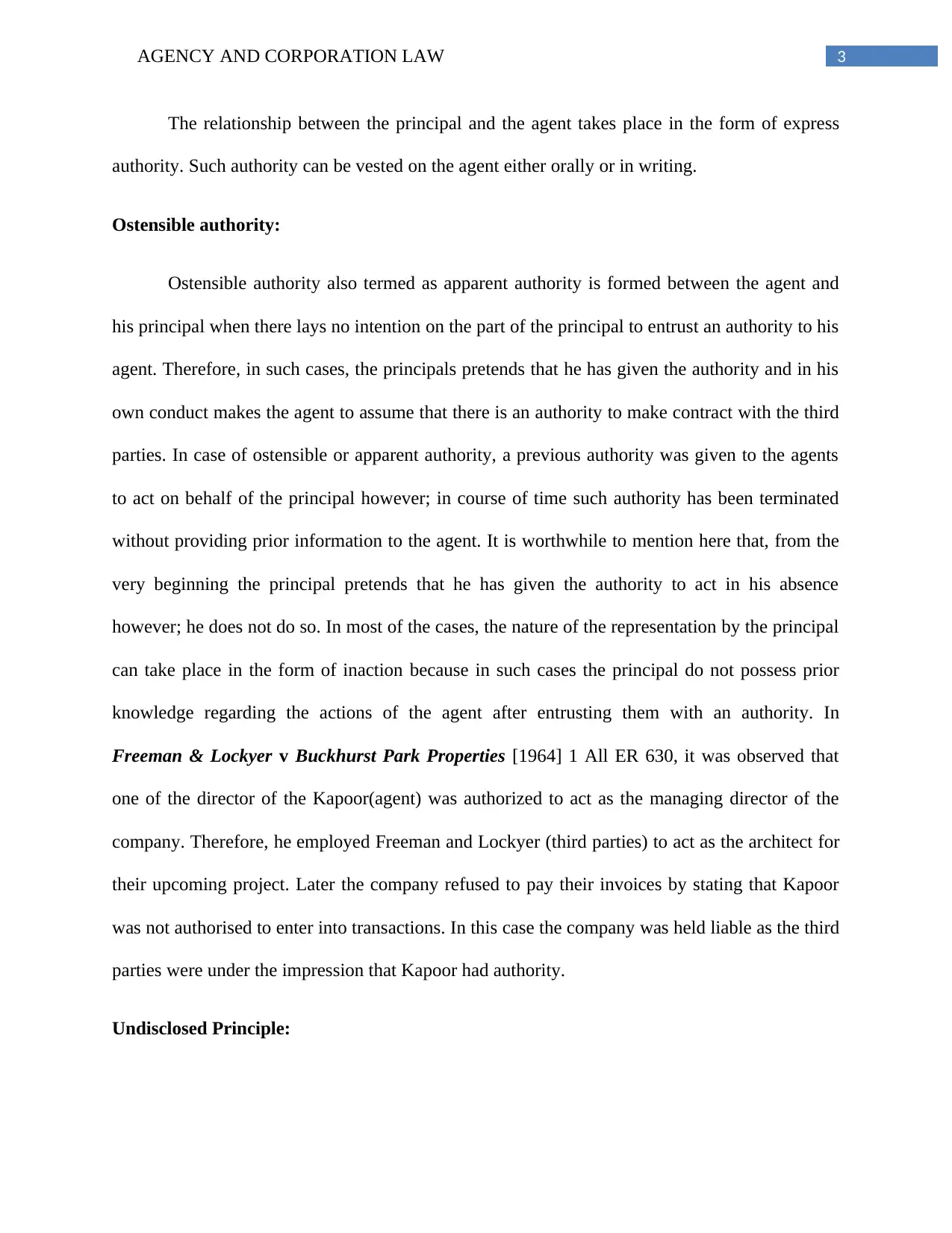
3AGENCY AND CORPORATION LAW
The relationship between the principal and the agent takes place in the form of express
authority. Such authority can be vested on the agent either orally or in writing.
Ostensible authority:
Ostensible authority also termed as apparent authority is formed between the agent and
his principal when there lays no intention on the part of the principal to entrust an authority to his
agent. Therefore, in such cases, the principals pretends that he has given the authority and in his
own conduct makes the agent to assume that there is an authority to make contract with the third
parties. In case of ostensible or apparent authority, a previous authority was given to the agents
to act on behalf of the principal however; in course of time such authority has been terminated
without providing prior information to the agent. It is worthwhile to mention here that, from the
very beginning the principal pretends that he has given the authority to act in his absence
however; he does not do so. In most of the cases, the nature of the representation by the principal
can take place in the form of inaction because in such cases the principal do not possess prior
knowledge regarding the actions of the agent after entrusting them with an authority. In
Freeman & Lockyer v Buckhurst Park Properties [1964] 1 All ER 630, it was observed that
one of the director of the Kapoor(agent) was authorized to act as the managing director of the
company. Therefore, he employed Freeman and Lockyer (third parties) to act as the architect for
their upcoming project. Later the company refused to pay their invoices by stating that Kapoor
was not authorised to enter into transactions. In this case the company was held liable as the third
parties were under the impression that Kapoor had authority.
Undisclosed Principle:
The relationship between the principal and the agent takes place in the form of express
authority. Such authority can be vested on the agent either orally or in writing.
Ostensible authority:
Ostensible authority also termed as apparent authority is formed between the agent and
his principal when there lays no intention on the part of the principal to entrust an authority to his
agent. Therefore, in such cases, the principals pretends that he has given the authority and in his
own conduct makes the agent to assume that there is an authority to make contract with the third
parties. In case of ostensible or apparent authority, a previous authority was given to the agents
to act on behalf of the principal however; in course of time such authority has been terminated
without providing prior information to the agent. It is worthwhile to mention here that, from the
very beginning the principal pretends that he has given the authority to act in his absence
however; he does not do so. In most of the cases, the nature of the representation by the principal
can take place in the form of inaction because in such cases the principal do not possess prior
knowledge regarding the actions of the agent after entrusting them with an authority. In
Freeman & Lockyer v Buckhurst Park Properties [1964] 1 All ER 630, it was observed that
one of the director of the Kapoor(agent) was authorized to act as the managing director of the
company. Therefore, he employed Freeman and Lockyer (third parties) to act as the architect for
their upcoming project. Later the company refused to pay their invoices by stating that Kapoor
was not authorised to enter into transactions. In this case the company was held liable as the third
parties were under the impression that Kapoor had authority.
Undisclosed Principle:
Paraphrase This Document
Need a fresh take? Get an instant paraphrase of this document with our AI Paraphraser
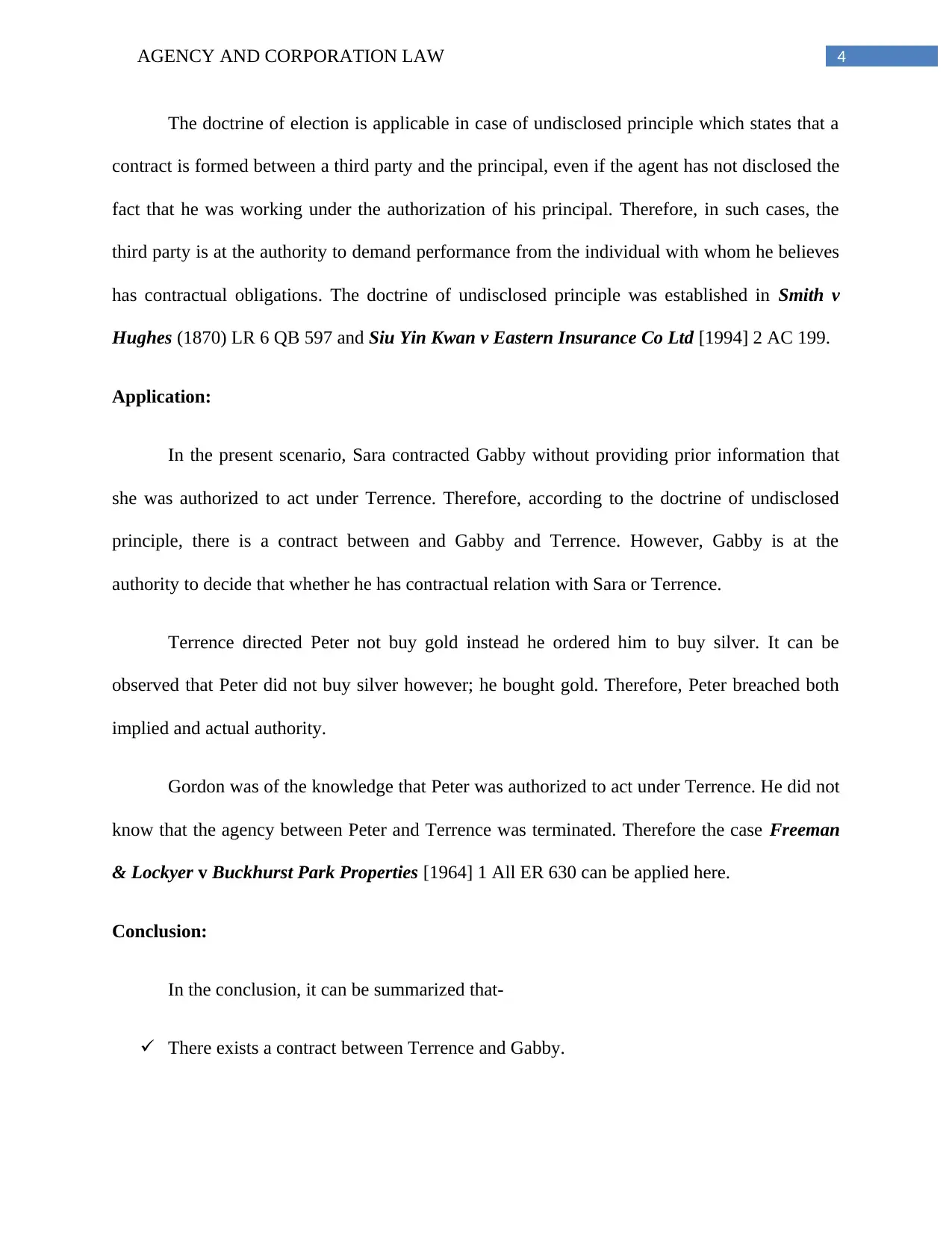
4AGENCY AND CORPORATION LAW
The doctrine of election is applicable in case of undisclosed principle which states that a
contract is formed between a third party and the principal, even if the agent has not disclosed the
fact that he was working under the authorization of his principal. Therefore, in such cases, the
third party is at the authority to demand performance from the individual with whom he believes
has contractual obligations. The doctrine of undisclosed principle was established in Smith v
Hughes (1870) LR 6 QB 597 and Siu Yin Kwan v Eastern Insurance Co Ltd [1994] 2 AC 199.
Application:
In the present scenario, Sara contracted Gabby without providing prior information that
she was authorized to act under Terrence. Therefore, according to the doctrine of undisclosed
principle, there is a contract between and Gabby and Terrence. However, Gabby is at the
authority to decide that whether he has contractual relation with Sara or Terrence.
Terrence directed Peter not buy gold instead he ordered him to buy silver. It can be
observed that Peter did not buy silver however; he bought gold. Therefore, Peter breached both
implied and actual authority.
Gordon was of the knowledge that Peter was authorized to act under Terrence. He did not
know that the agency between Peter and Terrence was terminated. Therefore the case Freeman
& Lockyer v Buckhurst Park Properties [1964] 1 All ER 630 can be applied here.
Conclusion:
In the conclusion, it can be summarized that-
There exists a contract between Terrence and Gabby.
The doctrine of election is applicable in case of undisclosed principle which states that a
contract is formed between a third party and the principal, even if the agent has not disclosed the
fact that he was working under the authorization of his principal. Therefore, in such cases, the
third party is at the authority to demand performance from the individual with whom he believes
has contractual obligations. The doctrine of undisclosed principle was established in Smith v
Hughes (1870) LR 6 QB 597 and Siu Yin Kwan v Eastern Insurance Co Ltd [1994] 2 AC 199.
Application:
In the present scenario, Sara contracted Gabby without providing prior information that
she was authorized to act under Terrence. Therefore, according to the doctrine of undisclosed
principle, there is a contract between and Gabby and Terrence. However, Gabby is at the
authority to decide that whether he has contractual relation with Sara or Terrence.
Terrence directed Peter not buy gold instead he ordered him to buy silver. It can be
observed that Peter did not buy silver however; he bought gold. Therefore, Peter breached both
implied and actual authority.
Gordon was of the knowledge that Peter was authorized to act under Terrence. He did not
know that the agency between Peter and Terrence was terminated. Therefore the case Freeman
& Lockyer v Buckhurst Park Properties [1964] 1 All ER 630 can be applied here.
Conclusion:
In the conclusion, it can be summarized that-
There exists a contract between Terrence and Gabby.
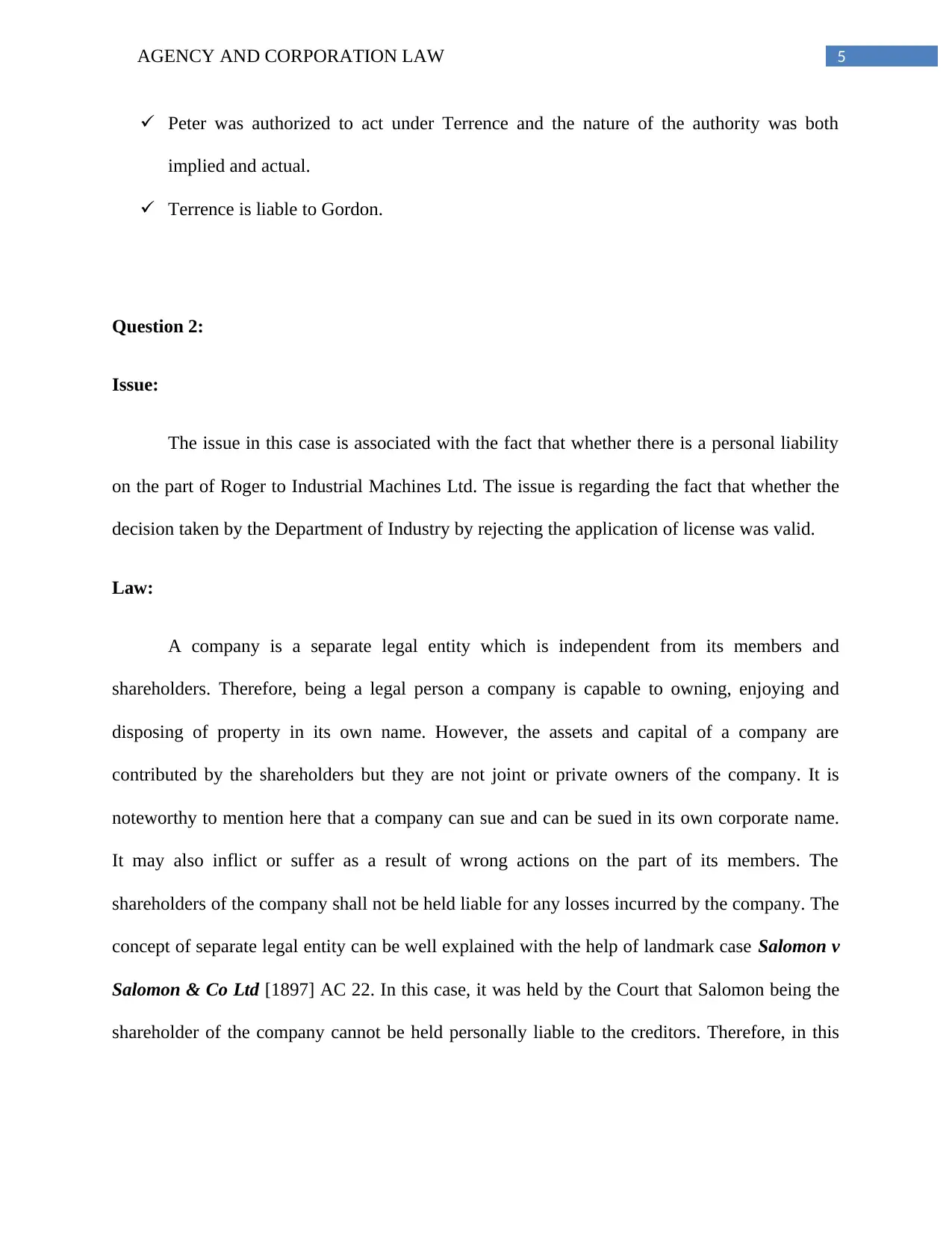
5AGENCY AND CORPORATION LAW
Peter was authorized to act under Terrence and the nature of the authority was both
implied and actual.
Terrence is liable to Gordon.
Question 2:
Issue:
The issue in this case is associated with the fact that whether there is a personal liability
on the part of Roger to Industrial Machines Ltd. The issue is regarding the fact that whether the
decision taken by the Department of Industry by rejecting the application of license was valid.
Law:
A company is a separate legal entity which is independent from its members and
shareholders. Therefore, being a legal person a company is capable to owning, enjoying and
disposing of property in its own name. However, the assets and capital of a company are
contributed by the shareholders but they are not joint or private owners of the company. It is
noteworthy to mention here that a company can sue and can be sued in its own corporate name.
It may also inflict or suffer as a result of wrong actions on the part of its members. The
shareholders of the company shall not be held liable for any losses incurred by the company. The
concept of separate legal entity can be well explained with the help of landmark case Salomon v
Salomon & Co Ltd [1897] AC 22. In this case, it was held by the Court that Salomon being the
shareholder of the company cannot be held personally liable to the creditors. Therefore, in this
Peter was authorized to act under Terrence and the nature of the authority was both
implied and actual.
Terrence is liable to Gordon.
Question 2:
Issue:
The issue in this case is associated with the fact that whether there is a personal liability
on the part of Roger to Industrial Machines Ltd. The issue is regarding the fact that whether the
decision taken by the Department of Industry by rejecting the application of license was valid.
Law:
A company is a separate legal entity which is independent from its members and
shareholders. Therefore, being a legal person a company is capable to owning, enjoying and
disposing of property in its own name. However, the assets and capital of a company are
contributed by the shareholders but they are not joint or private owners of the company. It is
noteworthy to mention here that a company can sue and can be sued in its own corporate name.
It may also inflict or suffer as a result of wrong actions on the part of its members. The
shareholders of the company shall not be held liable for any losses incurred by the company. The
concept of separate legal entity can be well explained with the help of landmark case Salomon v
Salomon & Co Ltd [1897] AC 22. In this case, it was held by the Court that Salomon being the
shareholder of the company cannot be held personally liable to the creditors. Therefore, in this
⊘ This is a preview!⊘
Do you want full access?
Subscribe today to unlock all pages.

Trusted by 1+ million students worldwide
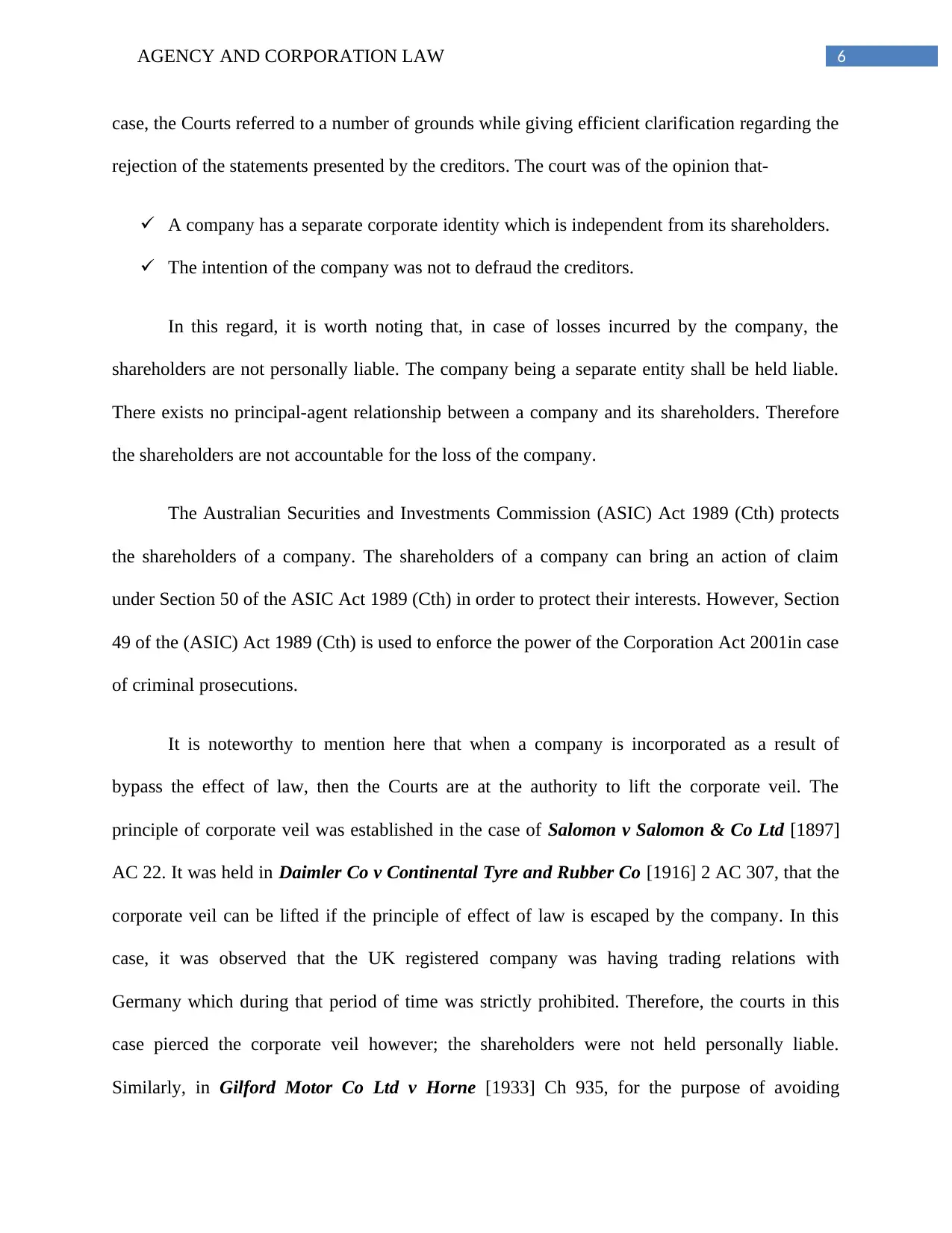
6AGENCY AND CORPORATION LAW
case, the Courts referred to a number of grounds while giving efficient clarification regarding the
rejection of the statements presented by the creditors. The court was of the opinion that-
A company has a separate corporate identity which is independent from its shareholders.
The intention of the company was not to defraud the creditors.
In this regard, it is worth noting that, in case of losses incurred by the company, the
shareholders are not personally liable. The company being a separate entity shall be held liable.
There exists no principal-agent relationship between a company and its shareholders. Therefore
the shareholders are not accountable for the loss of the company.
The Australian Securities and Investments Commission (ASIC) Act 1989 (Cth) protects
the shareholders of a company. The shareholders of a company can bring an action of claim
under Section 50 of the ASIC Act 1989 (Cth) in order to protect their interests. However, Section
49 of the (ASIC) Act 1989 (Cth) is used to enforce the power of the Corporation Act 2001in case
of criminal prosecutions.
It is noteworthy to mention here that when a company is incorporated as a result of
bypass the effect of law, then the Courts are at the authority to lift the corporate veil. The
principle of corporate veil was established in the case of Salomon v Salomon & Co Ltd [1897]
AC 22. It was held in Daimler Co v Continental Tyre and Rubber Co [1916] 2 AC 307, that the
corporate veil can be lifted if the principle of effect of law is escaped by the company. In this
case, it was observed that the UK registered company was having trading relations with
Germany which during that period of time was strictly prohibited. Therefore, the courts in this
case pierced the corporate veil however; the shareholders were not held personally liable.
Similarly, in Gilford Motor Co Ltd v Horne [1933] Ch 935, for the purpose of avoiding
case, the Courts referred to a number of grounds while giving efficient clarification regarding the
rejection of the statements presented by the creditors. The court was of the opinion that-
A company has a separate corporate identity which is independent from its shareholders.
The intention of the company was not to defraud the creditors.
In this regard, it is worth noting that, in case of losses incurred by the company, the
shareholders are not personally liable. The company being a separate entity shall be held liable.
There exists no principal-agent relationship between a company and its shareholders. Therefore
the shareholders are not accountable for the loss of the company.
The Australian Securities and Investments Commission (ASIC) Act 1989 (Cth) protects
the shareholders of a company. The shareholders of a company can bring an action of claim
under Section 50 of the ASIC Act 1989 (Cth) in order to protect their interests. However, Section
49 of the (ASIC) Act 1989 (Cth) is used to enforce the power of the Corporation Act 2001in case
of criminal prosecutions.
It is noteworthy to mention here that when a company is incorporated as a result of
bypass the effect of law, then the Courts are at the authority to lift the corporate veil. The
principle of corporate veil was established in the case of Salomon v Salomon & Co Ltd [1897]
AC 22. It was held in Daimler Co v Continental Tyre and Rubber Co [1916] 2 AC 307, that the
corporate veil can be lifted if the principle of effect of law is escaped by the company. In this
case, it was observed that the UK registered company was having trading relations with
Germany which during that period of time was strictly prohibited. Therefore, the courts in this
case pierced the corporate veil however; the shareholders were not held personally liable.
Similarly, in Gilford Motor Co Ltd v Horne [1933] Ch 935, for the purpose of avoiding
Paraphrase This Document
Need a fresh take? Get an instant paraphrase of this document with our AI Paraphraser
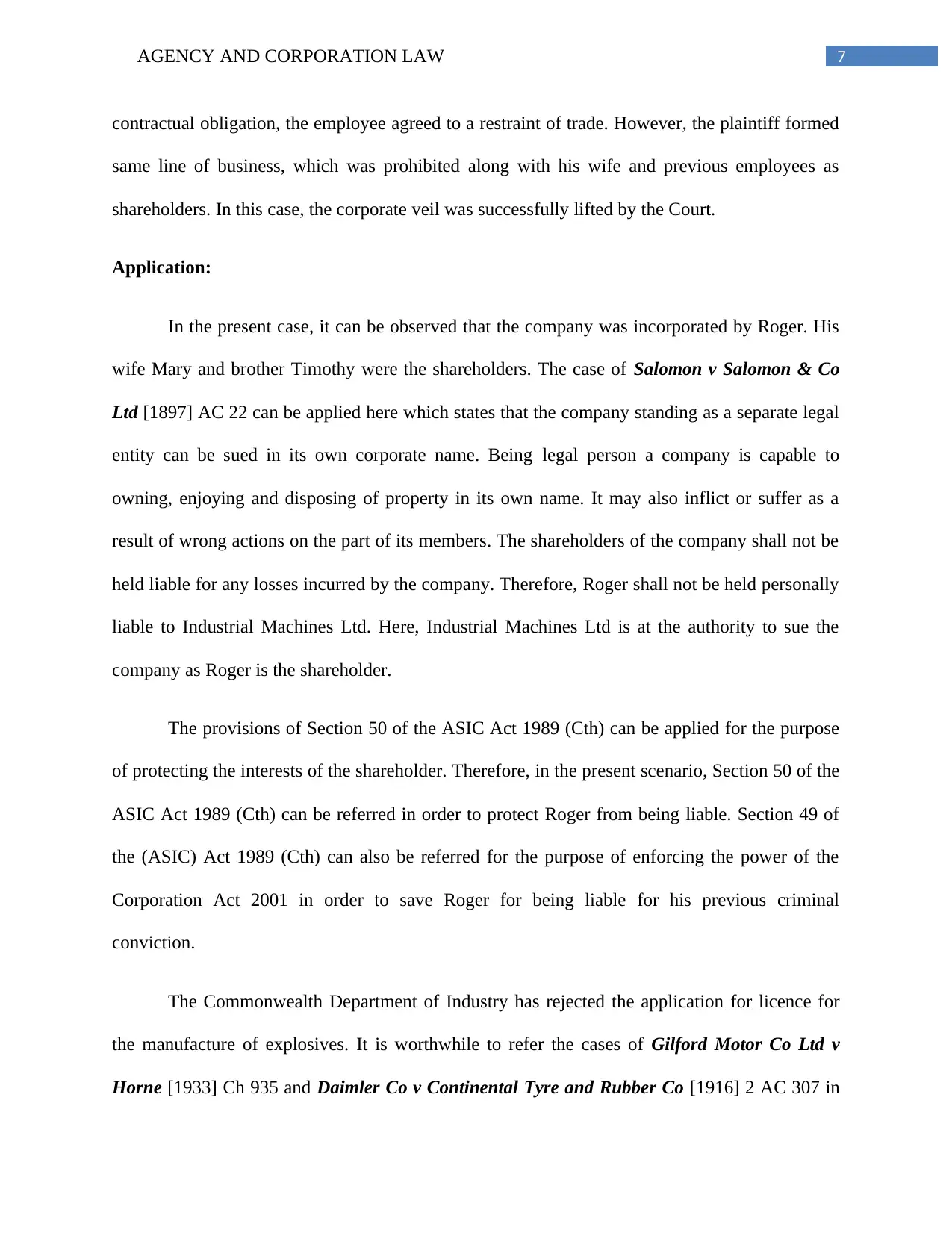
7AGENCY AND CORPORATION LAW
contractual obligation, the employee agreed to a restraint of trade. However, the plaintiff formed
same line of business, which was prohibited along with his wife and previous employees as
shareholders. In this case, the corporate veil was successfully lifted by the Court.
Application:
In the present case, it can be observed that the company was incorporated by Roger. His
wife Mary and brother Timothy were the shareholders. The case of Salomon v Salomon & Co
Ltd [1897] AC 22 can be applied here which states that the company standing as a separate legal
entity can be sued in its own corporate name. Being legal person a company is capable to
owning, enjoying and disposing of property in its own name. It may also inflict or suffer as a
result of wrong actions on the part of its members. The shareholders of the company shall not be
held liable for any losses incurred by the company. Therefore, Roger shall not be held personally
liable to Industrial Machines Ltd. Here, Industrial Machines Ltd is at the authority to sue the
company as Roger is the shareholder.
The provisions of Section 50 of the ASIC Act 1989 (Cth) can be applied for the purpose
of protecting the interests of the shareholder. Therefore, in the present scenario, Section 50 of the
ASIC Act 1989 (Cth) can be referred in order to protect Roger from being liable. Section 49 of
the (ASIC) Act 1989 (Cth) can also be referred for the purpose of enforcing the power of the
Corporation Act 2001 in order to save Roger for being liable for his previous criminal
conviction.
The Commonwealth Department of Industry has rejected the application for licence for
the manufacture of explosives. It is worthwhile to refer the cases of Gilford Motor Co Ltd v
Horne [1933] Ch 935 and Daimler Co v Continental Tyre and Rubber Co [1916] 2 AC 307 in
contractual obligation, the employee agreed to a restraint of trade. However, the plaintiff formed
same line of business, which was prohibited along with his wife and previous employees as
shareholders. In this case, the corporate veil was successfully lifted by the Court.
Application:
In the present case, it can be observed that the company was incorporated by Roger. His
wife Mary and brother Timothy were the shareholders. The case of Salomon v Salomon & Co
Ltd [1897] AC 22 can be applied here which states that the company standing as a separate legal
entity can be sued in its own corporate name. Being legal person a company is capable to
owning, enjoying and disposing of property in its own name. It may also inflict or suffer as a
result of wrong actions on the part of its members. The shareholders of the company shall not be
held liable for any losses incurred by the company. Therefore, Roger shall not be held personally
liable to Industrial Machines Ltd. Here, Industrial Machines Ltd is at the authority to sue the
company as Roger is the shareholder.
The provisions of Section 50 of the ASIC Act 1989 (Cth) can be applied for the purpose
of protecting the interests of the shareholder. Therefore, in the present scenario, Section 50 of the
ASIC Act 1989 (Cth) can be referred in order to protect Roger from being liable. Section 49 of
the (ASIC) Act 1989 (Cth) can also be referred for the purpose of enforcing the power of the
Corporation Act 2001 in order to save Roger for being liable for his previous criminal
conviction.
The Commonwealth Department of Industry has rejected the application for licence for
the manufacture of explosives. It is worthwhile to refer the cases of Gilford Motor Co Ltd v
Horne [1933] Ch 935 and Daimler Co v Continental Tyre and Rubber Co [1916] 2 AC 307 in
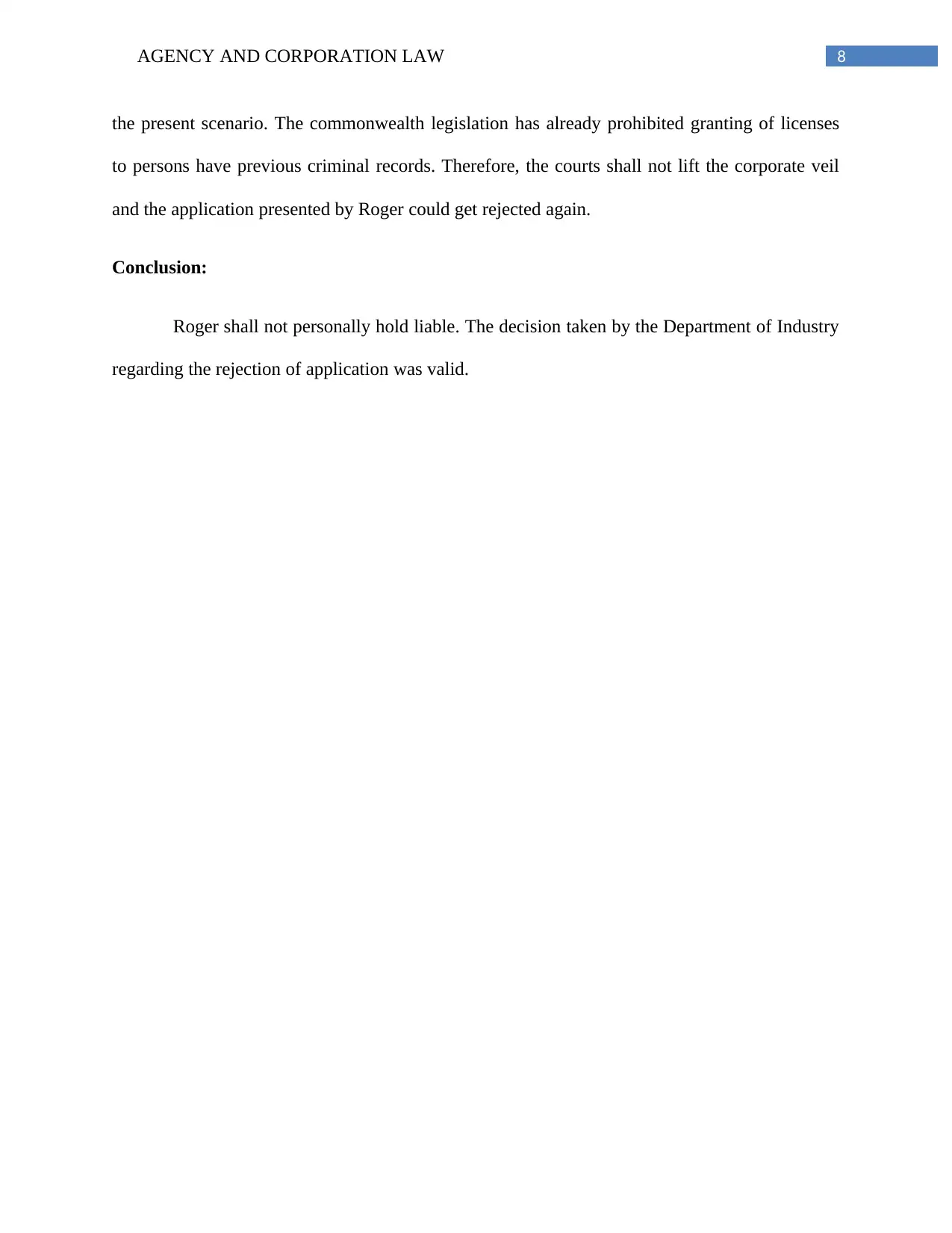
8AGENCY AND CORPORATION LAW
the present scenario. The commonwealth legislation has already prohibited granting of licenses
to persons have previous criminal records. Therefore, the courts shall not lift the corporate veil
and the application presented by Roger could get rejected again.
Conclusion:
Roger shall not personally hold liable. The decision taken by the Department of Industry
regarding the rejection of application was valid.
the present scenario. The commonwealth legislation has already prohibited granting of licenses
to persons have previous criminal records. Therefore, the courts shall not lift the corporate veil
and the application presented by Roger could get rejected again.
Conclusion:
Roger shall not personally hold liable. The decision taken by the Department of Industry
regarding the rejection of application was valid.
⊘ This is a preview!⊘
Do you want full access?
Subscribe today to unlock all pages.

Trusted by 1+ million students worldwide
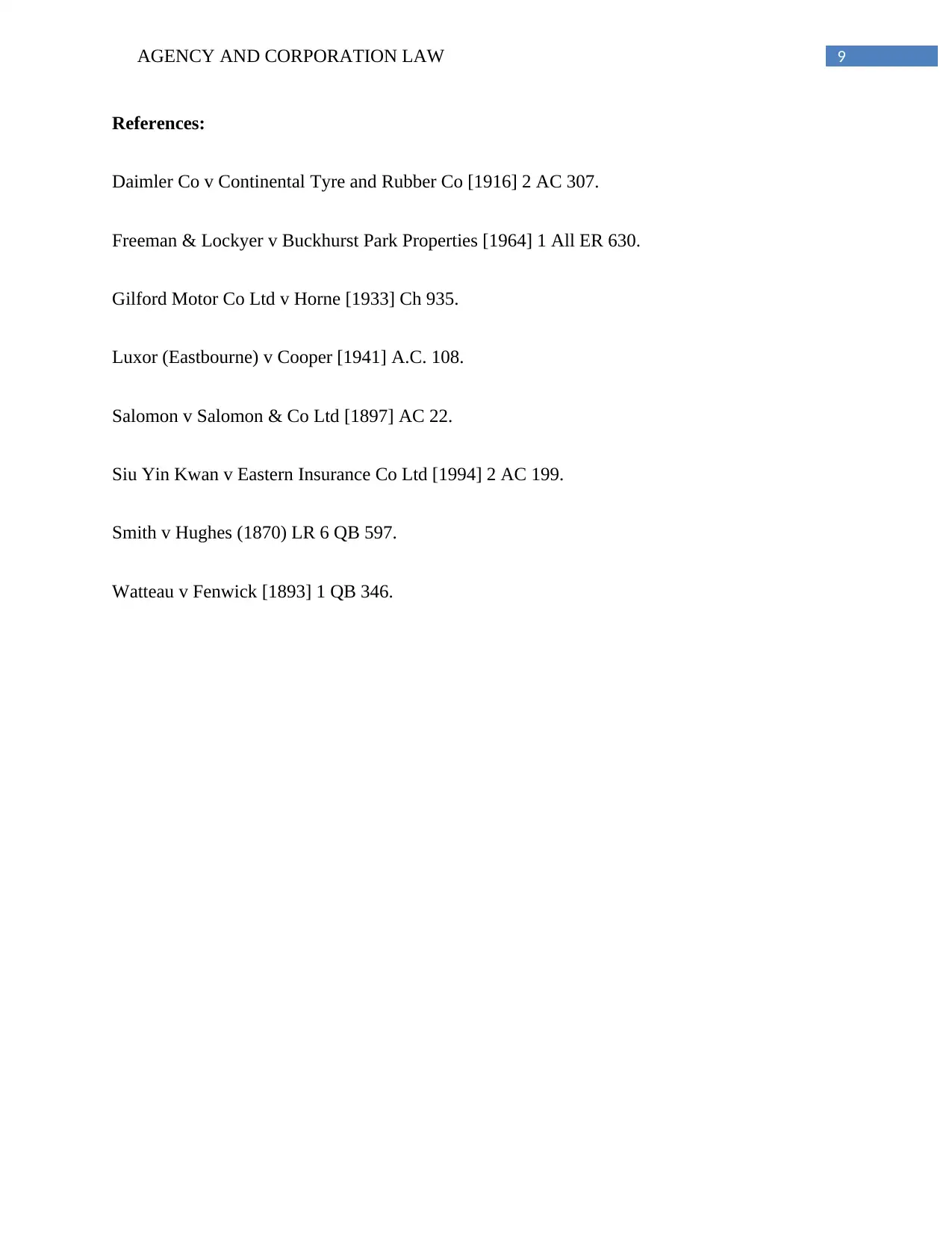
9AGENCY AND CORPORATION LAW
References:
Daimler Co v Continental Tyre and Rubber Co [1916] 2 AC 307.
Freeman & Lockyer v Buckhurst Park Properties [1964] 1 All ER 630.
Gilford Motor Co Ltd v Horne [1933] Ch 935.
Luxor (Eastbourne) v Cooper [1941] A.C. 108.
Salomon v Salomon & Co Ltd [1897] AC 22.
Siu Yin Kwan v Eastern Insurance Co Ltd [1994] 2 AC 199.
Smith v Hughes (1870) LR 6 QB 597.
Watteau v Fenwick [1893] 1 QB 346.
References:
Daimler Co v Continental Tyre and Rubber Co [1916] 2 AC 307.
Freeman & Lockyer v Buckhurst Park Properties [1964] 1 All ER 630.
Gilford Motor Co Ltd v Horne [1933] Ch 935.
Luxor (Eastbourne) v Cooper [1941] A.C. 108.
Salomon v Salomon & Co Ltd [1897] AC 22.
Siu Yin Kwan v Eastern Insurance Co Ltd [1994] 2 AC 199.
Smith v Hughes (1870) LR 6 QB 597.
Watteau v Fenwick [1893] 1 QB 346.
1 out of 10
Related Documents
Your All-in-One AI-Powered Toolkit for Academic Success.
+13062052269
info@desklib.com
Available 24*7 on WhatsApp / Email
![[object Object]](/_next/static/media/star-bottom.7253800d.svg)
Unlock your academic potential
Copyright © 2020–2025 A2Z Services. All Rights Reserved. Developed and managed by ZUCOL.




